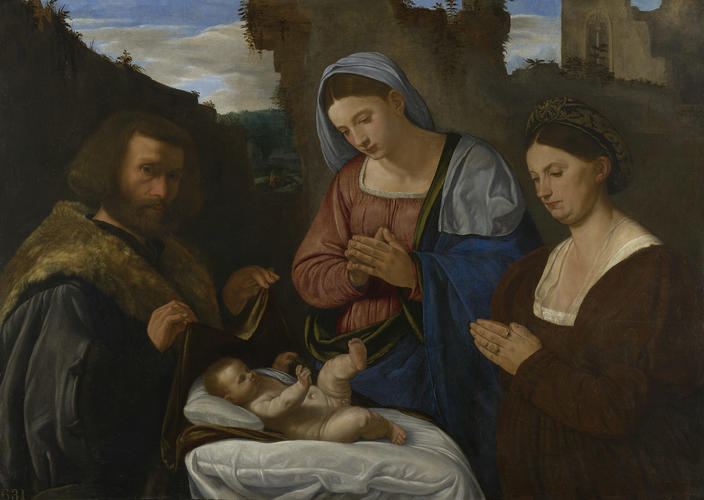The Virgin Adoring the Child with Two Donors c. 1527
Oil on canvas | 102.2 x 139.7 cm (support, canvas/panel/stretcher external) | RCIN 405755
-
The concentrated colours and glossy metallic effect of the folds of drapery shown here are typical of Savoldo’s work in the late 1520s. The distant vista and close observation of natural details reflect Savoldo’s interest in German and Netherlandish art.
This is rare example of a signed and dated painting by Savoldo. The signature was revealed by a restoration in 1867, at which point the date was read as 1527; restoration work carried out in 1969 suggested that these numbers were strengthened (or even added) a century earlier; the date is now indecipherable. If the 1527 was an accurate reading of an original date, as some have suggested, then it is not inconsistent with the style of the painting. John Shearman dated it to the mid-1520s on the grounds of the similarity of the female donor’s headdress to that in the Licinio 'Family Group' (Royal Collection) of 1524; it is also close to a Licinio portrait in the Borghese Gallery, Rome, which is generally dated slightly later. The concentrated colours of the drapery with the glossy metallic effect of folds, particularly in the veil of the Virgin, is typical of Savoldo’s work in the late 1520s, such as his 'St Jerome' (National Gallery, London) commissioned in 1527.
There is a closely related painting in the Galleria Sabauda, Turin, in which the two donors are replaced by St Jerome and St Francis. Both paintings have been x-radiographed and in both cases changes have occurred during the painting process, which suggests that neither one is a mechanical copy of the other. In the Royal Collection version there is extensive fluid underdrawing with the brush, visible to the naked eye in places and elsewhere through infra-red analysis. The Virgin’s face was defined with heavy lines, as if following a cartoon, but the donors’ faces have lighter, more searching lines. Originally the face of the woman on the right lacked the double chin, which now creates such a striking impression of down-to-earth realism by comparison with that of the Virgin. The drapery in this painting is softer than in the Turin version and the light suggestive of late afternoon rather than evening, as it falls from high up on the left, casting complex shadows and creating a more powerful sense of space.
It is now generally agreed that the Turin painting came first, particularly because the gesture of lifting the cloth to reveal the Christ Child seems more appropriate for a saint especially Jerome, translator of the Bible, (as in that version) than a donor (as here): it is usually the Virgin who lifts the Christ Child’s bedcover in this way to reveal him to his worshippers as illustrated in Carracci’s 'Il Silenzio' (Royal Collection). The action has been seen as a premonition of the shroud covering the dead Christ. John Shearman even suggests that the unknown donor here might have been called Giuseppe (Joseph) and the action chosen to allude to Joseph of Arimathea who helped at Christ’s entombment.
Savoldo married a Flemish widow, Maria di Tijlandrija, possibly after 1527, and frequently incorporated compositional details from northern sources into his work. The distant vista and the close observation of natural details here reflect his interest in Netherlandish and German art, in particular the airy landscapes of Joachim Patinir. There are similarities between this composition and that of the 'Nativity' of c.1480 by Jean Hey (Master of Moulins) (Musée Rolin, Autun), in which a praying donor and Virgin adore the Christ Child.
Signed upper right (indistinctly): Hieronimus Savoldus.d. Bresia faciebat
Catalogue entry adapted from The Art of Italy in the Royal Collection: Renaissance and Baroque, London, 2007Provenance
Probably acquired by Charles I and the picture attributed to Titian appraised at the Galleries in Greenwich Palace at £60 on 8 September 1649 (no 100); still attributed to Titian in the Store at Whitehall in 1666 (no 489)
-
Medium and techniques
Oil on canvas
Measurements
102.2 x 139.7 cm (support, canvas/panel/stretcher external)
113.6 x 154.4 x 10.2 cm (frame, external)
Category
Object type(s)
Other number(s)
Alternative title(s)
The Virgin and Child with Saints Joseph and Elizabeth, previously entitled
The Virgin, donor and donatrix adoring the Child, previously entitled









